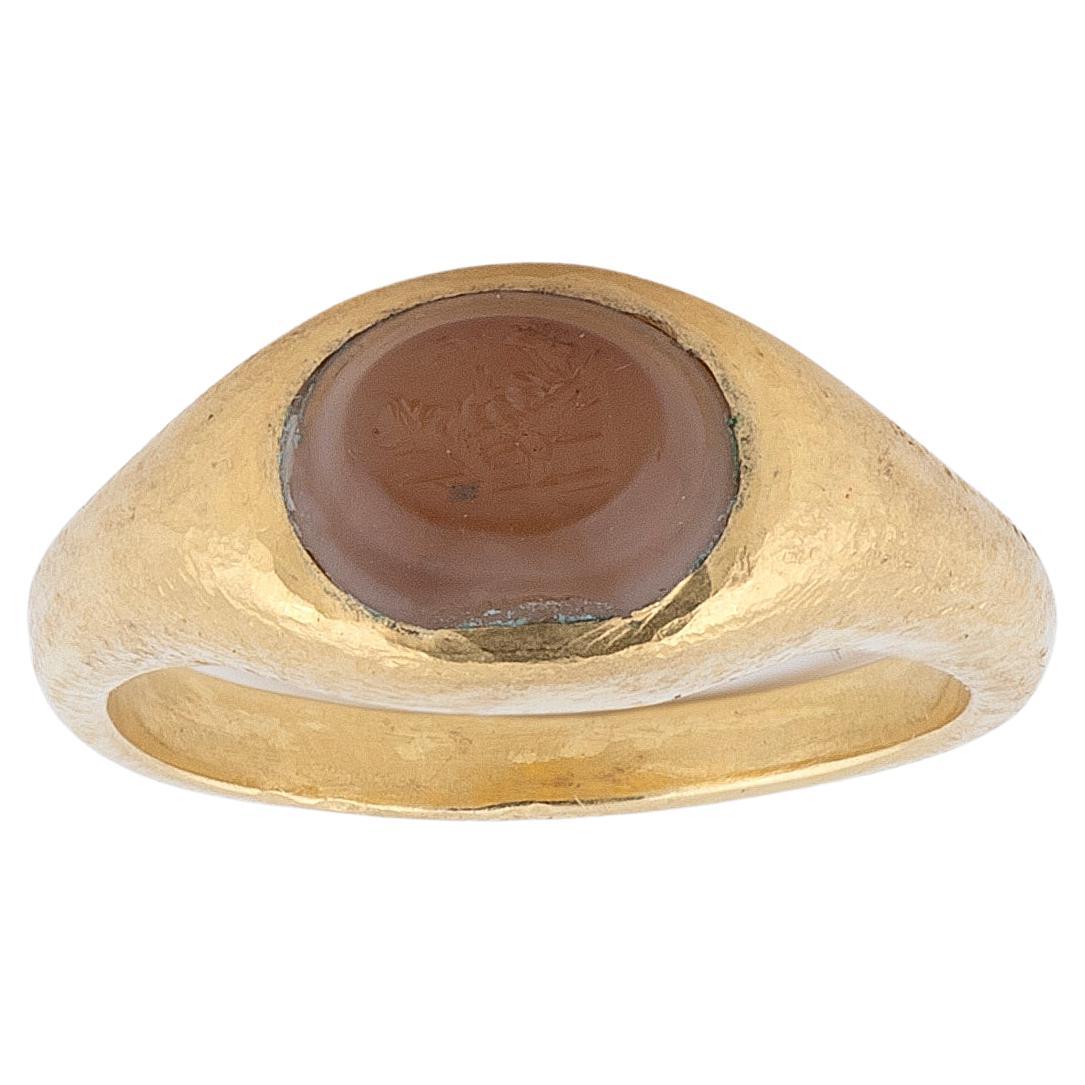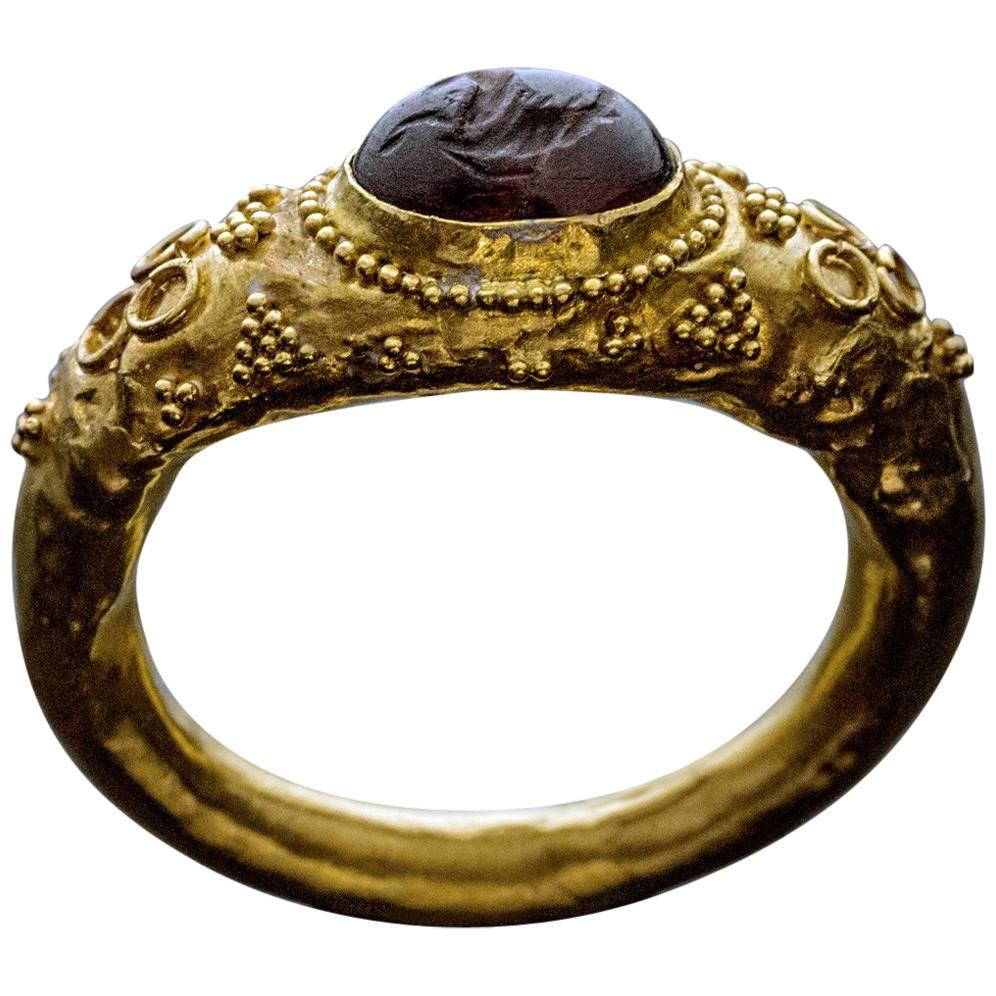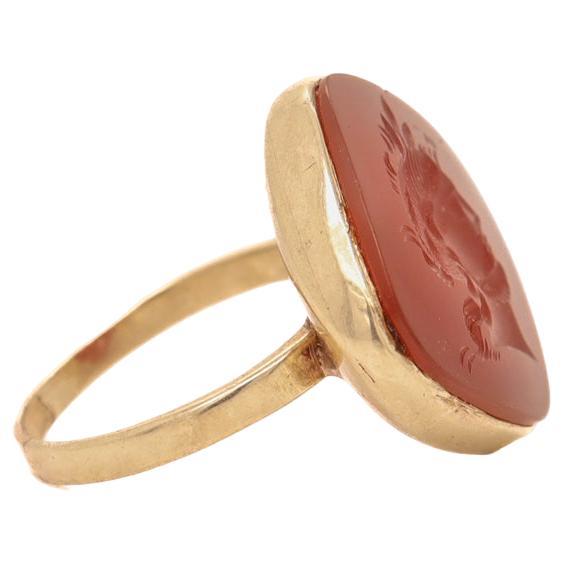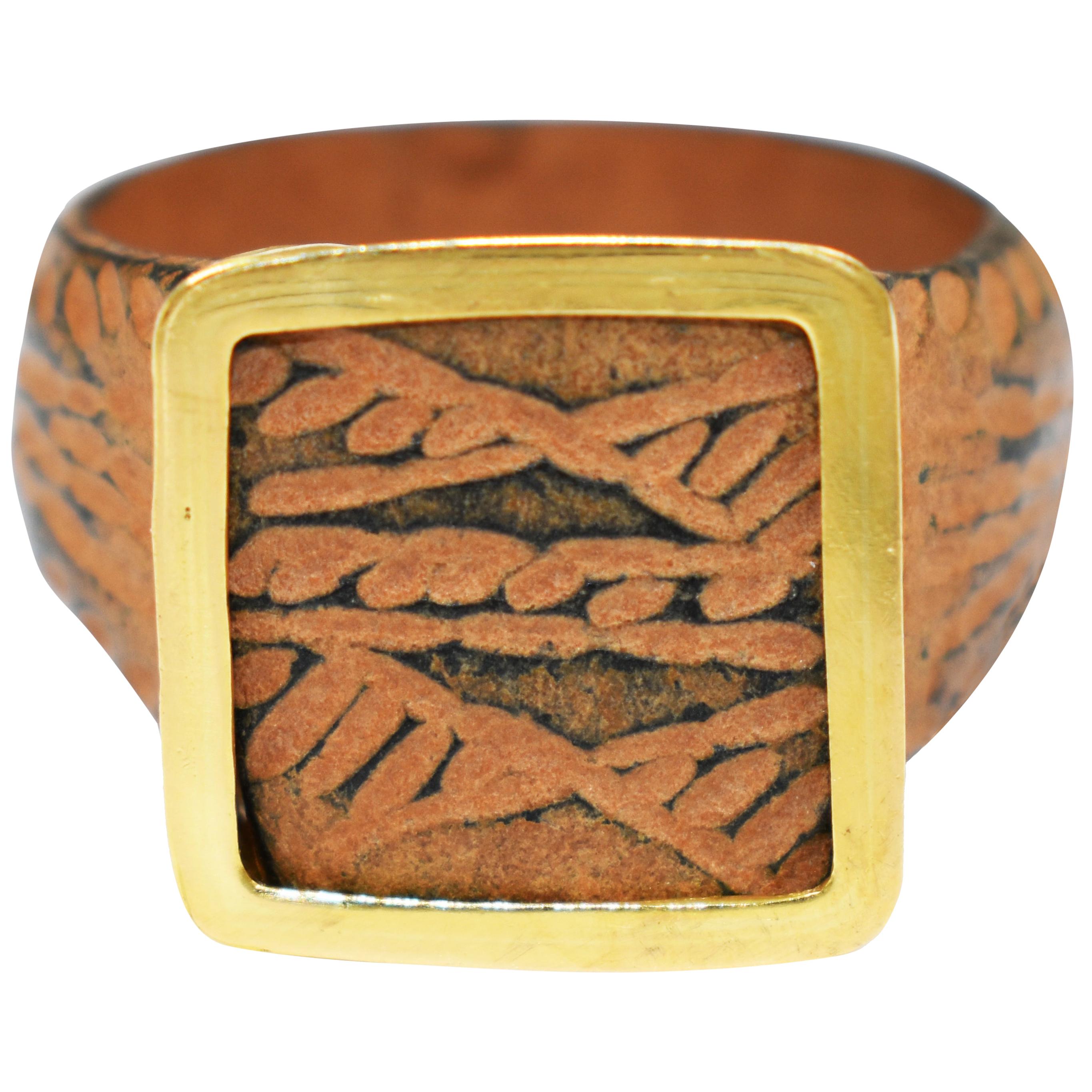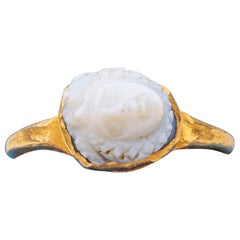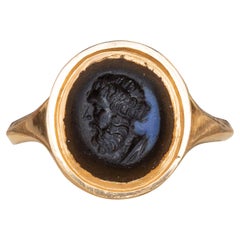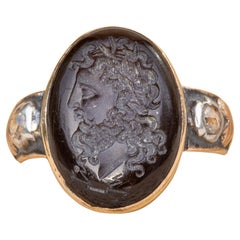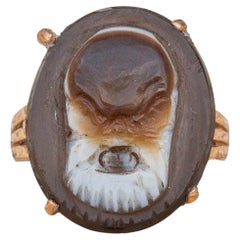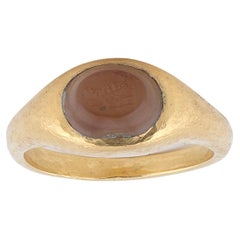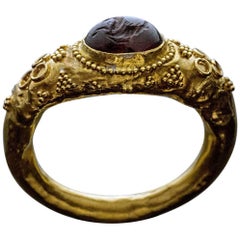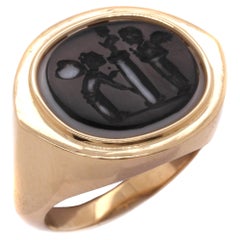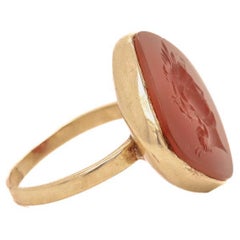Items Similar to Ancient Roman Gold Mens Signet Ring Conical Intaglio Ring Gem Carving
Want more images or videos?
Request additional images or videos from the seller
1 of 16
Ancient Roman Gold Mens Signet Ring Conical Intaglio Ring Gem Carving
About the Item
A superb ancient Roman agate intaglio ring. The high-karat gold signet ring is set with an engraved gemstone, known as an ‘intaglio’. It dates from between the 2nd to 3rd century AD and is a fine example of a Romano-British intaglio.
The conical-shaped agate gemstone displays various bands of colour ranging from honey brown to greyish-blue. The engraving depicts the bust of a man wearing a helmet, possibly winged which would depict Mercury, the Roman god of commerce, financial gain and communication. In Roman times, people would wear rings with the intaglio of Mercury in hope that the he would protect them and bless them with good financial fortune in their lives.
A number of referenced examples of similar ancient Roman conical shaped intaglios reside in notable museums all across the world, from the British Museum to the Louvre. A page with these examples and their sources can be found in the final photos of the listing. Similar examples can also be found in the extensive Alice and Louis Koch collection (items: 234, 235, 241, 301). Again see final images for reference.
The gold ring mount is of D-shaped cross-section and a hollow 22K gold construction. The ring has a fantastic smooth silk-like texture when worn. It remains in good overall condition and the intaglio is very secure in the mount. The gold mount dates to the late 18th to early 19th century, and the shape is inspired by ancient Roman ring mounts. During this period, many ancient intaglios were collected and repurposed into jewellery, forming some of the most notable intaglio collections that exist today.
UK size O 1/2, US size 7.5
The ring weighs 4.15 grams. The gold ring is unmarked but tests as 22K gold.
A truly remarkable survivor, this ring would be an excellent addition to any collection or for anyone looking to wear a tangible piece of history!
The ancient Romans considered jewellery to be an essential dressing accessory, for it provided a public display of their wealth. The custom of wearing rings was probably introduced by the Sabines, who are described in early legends as wearing gold rings with precious stones. During the Roman Republic it became customary for all the senators, chief magistrates, and at last for the equites also, to wear gold rings.
- Ring Size:7.5 US, Not Resizable
- Metal:
- Stone:
- Stone Cut:
- Weight:4.15 g
- Period:
- Date of Manufacture:Unknown
- Condition:
- Seller Location:London, GB
- Reference Number:Seller: 100761stDibs: LU2845224962312
About the Seller
5.0
Vetted Professional Seller
Every seller passes strict standards for authenticity and reliability
Established in 2019
1stDibs seller since 2022
46 sales on 1stDibs
Typical response time: 1 to 2 days
- ShippingRetrieving quote...Shipping from: London, United Kingdom
- Return Policy
Authenticity Guarantee
In the unlikely event there’s an issue with an item’s authenticity, contact us within 1 year for a full refund. DetailsMoney-Back Guarantee
If your item is not as described, is damaged in transit, or does not arrive, contact us within 7 days for a full refund. Details24-Hour Cancellation
You have a 24-hour grace period in which to reconsider your purchase, with no questions asked.Vetted Professional Sellers
Our world-class sellers must adhere to strict standards for service and quality, maintaining the integrity of our listings.Price-Match Guarantee
If you find that a seller listed the same item for a lower price elsewhere, we’ll match it.Trusted Global Delivery
Our best-in-class carrier network provides specialized shipping options worldwide, including custom delivery.More From This Seller
View AllSmall Ancient Roman Medusa Carved Cameo Gold Ring 2nd Century Gem Carving
Located in London, GB
A scarce and small ancient Roman gold Medusa cameo ring, circa 2nd to 3rd century AD.
The carved layered onyx gemstone is white in colour and depicts the bust of Medusa engraved wit...
Category
Antique 15th Century and Earlier Italian Classical Roman Signet Rings
Materials
Onyx, Gold
Georgian 18th Century Signet Ring with Ancient Roman Nicolo Intaglio of Hercules
Located in London, GB
A superb ancient Roman nicolo intaglio set in a late 18th century gold signet ring. Nicolo intaglios are a particular type of intaglio ma...
Category
Antique Late 18th Century English Georgian Signet Rings
18th Century Garnet Intaglio Signet Ring
Located in London, GB
Rare Antique Late 18th Century Garnet Intaglio Signet Ring with Rose Cut Diamonds
This fantastic signet ring dates to around 1780 and was made in Paris. A closed-back and bezel set ...
Category
Antique Late 18th Century Neoclassical Signet Rings
Materials
Diamond, Garnet, 14k Gold, Silver
Antique Gold Cameo Ring Greek Theatre Mask Silenus Hardstone Intaglio Signet
Located in London, GB
A very unusual antique gold ring set with a carved brown and white hardstone cameo depicting the theatrical comic mask of Silenus, the Greek mythological old rustic god of wine-making and drunkenness. The ring was made in the late 19th century and carries French control marks for 18K gold, whilst the cameo is probably Italian and made slightly earlier, circa 1800.
Silenus was a companion to the wine god Dionysus, and suitably he was a notorious consumer of wine, usually drunk and supported by satyrs or carried by a donkey. Silenus was described as the oldest, wisest and most drunken of the followers of Dionysus, and was said to possess special knowledge and the power of prophecy when intoxicated. He presides over the other satyrs and is related to musical creativity, prophetic ecstasy, drunken joy and drunken dances.
Silenus was usually depicted as a jovial old man, bald yet bearded, with a pot-belly, thick lips and snub-nose. The masks worn to play him in theatre really emphasised these features, as you can see with this cameo carving
Theatre was a key part of ancient Greek culture. The theatrical masks worn by the actors, known as ‘prosopon’, served various purposes. They enabled individual actors to play multiple roles (or genders) in the same performance; the exaggerated expressions helped define the character being portrayed; they helped spectators in the back rows to tell the characters apart. This particular masked as mentioned before is a comedic Silenus, please see final photo for other examples of Silenus masks in museum collections.
UK size N 1/2, US size 7
4.84g 18K gold
French ‘tête...
Category
Antique Early 19th Century Italian Georgian Signet Rings
Materials
Agate, 18k Gold
French Neo-Renaissance Intaglio Signet Ring Manner of Wièse & Froment-Meurice
Located in London, GB
A fantastic French 19th century Neorenaissance silver intaglio ring, in the manner of Jules Wièse and Froment-Meurice, circa 1840. The milky blue ...
Category
Antique Mid-19th Century French Belle Époque Signet Rings
Materials
Chalcedony, Silver
Ancient Gold Amethyst Engraved Scorpion Ring Early Javanese Intaglio Ring
Located in London, GB
This scarce gold intaglio ring dates to the Indonesian Classical period, circa 8th–10th century.
The ring is crafted from high-karat gold (22K), featuring a circular bezel that holds an amethyst gemstone engraved with a scorpion motif. Scorpions were often considered symbols of protection in ancient traditions, aligning with Javanese beliefs that rings possessed magical properties to bring good fortune and guard against harm.
The stirrup-shaped shoulders, designed to mimic the form of water buffalo horns, are a hallmark of early Javanese craftsmanship. This distinctive design reflects both artistic expression and cultural symbolism rooted in Java’s agricultural and spiritual traditions.
Java, one of Indonesia’s largest islands, was a significant centre of civilisation and artistry during this period. Gold rings were not merely decorative but also served as currency, payment for fines, dowries, and even wedding feasts. Imported gemstones, like the present amethyst, were chosen for their astrological, magical, and medicinal properties, further enhancing their importance in Javanese society.
Referenced Examples:
Similar rings can be found in the Metropolitan Museum of Art (Accession No. 1998.544.298).
Additional examples are catalogued in Java Gold...
Category
Antique 15th Century and Earlier Engagement Rings
Materials
Amethyst, 22k Gold
You May Also Like
Ancient Roman Gold Mens Signet Ring Conical Intaglio Ring Gem Carving Jupiter
Located in Firenze, IT
A superb ancient Roman agate intaglio ring. The high-karat gold signet ring is set with an engraved gemstone, known as an ‘intaglio’. It dates from between the 2nd to 3rd century AD ...
Category
Antique 15th Century and Earlier Italian Classical Roman Signet Rings
Materials
Agate, 18k Gold, Yellow Gold
Ancient Roman Garnet Intaglio Gold Ring
Located in Chicago, IL
A museum quality ancient Roman gold ring, circa 400 AD.
This hollow ring is bezel-set with a garnet intaglio of Hippocamp – a fish-tailed horse that w...
Category
Antique 15th Century and Earlier Signet Rings
Castellani Ancient Roman Agate Intaglio Gold Ring
By Castellani
Located in New York, NY
Castellani® has selected this Ancient Roman Agate Intaglio for the "Cleopatra" Ring Setting.
The intaglio dates to the 3rd to 7th Century.
The intaglio is both black and white agate, which is a hard stone and very good for carving. The agate has two layers of color, black on the top and white at the bottom. The agate intaglio is solid and is one piece. The carver was able to use these two color layers to give dimension and detail. The Column and Angel on the left wings are white and the balance is all black. The Carver knew the material he/she was carving and used this to create this very unique scene.
The intaglio shows two angels standing on either side of a column/pillar looking at the bust of a man on top of the pillar.
The angels are female and male. The bust on the pedestal is of a male.
The intaglio is set below the frame. The frame flairs out to a subtle point on the sides and has a flat surface.
The "Cleopatra" ring design was a style that Castellani created in the 1860's and was inspired by Ancient Roman rings...
Category
21st Century and Contemporary American Etruscan Revival Signet Rings
Materials
Agate, 18k Gold, Gold
Antique Gold & Carved Carnelian Intaglio Signet Ring with an Ancient Roman Hero
Located in Philadelphia, PA
A fine antique intaglio ring.
Likely converted from an antique button or pin.
In 14k gold
With a carved carnelian cabochon depicting an unidentified Roman hero.
Marked 14k to the...
Category
20th Century Etruscan Revival Signet Rings
Materials
Carnelian, Gold
Ancient Roman Carnelian Intaglio Ring with Clasped Hands
Located in Stamford, CT
We are proud to show this circular hoop of 22 Kt gold, with coiling around the shoulders, sets an oval shaped intaglio"dextrarum lunctio" on the carnelian. This translates to clasped...
Category
Antique 15th Century and Earlier Italian Classical Roman Band Rings
Materials
Carnelian, 22k Gold
Ancient Roman Bronze Signet Ring with 22 Karat Gold Bezel
By Vicki Orr
Located in Naples, FL
Authentic ancient Roman carved bronze signet ring (1st-4th century AD) with newly added 22k yellow gold bezel. Ring is approximately size 7. Squar...
Category
Antique 15th Century and Earlier American Classical Roman Signet Rings
Materials
Gold, 22k Gold, Yellow Gold, Bronze
Recently Viewed
View AllMore Ways To Browse
British Helmet
Victorian Reading Glasses
Vintage 17 Jewels Incabloc Swiss Made Watch
Vintage Arpel Diamond A Toi Et Moi Ring
Vintage Avia Watch Wristwatches
Vintage Bergere Bracelet
Vintage Breitling Premier Watch
Vintage Bulova Cocktail Watch
Vintage Bvlgari Parentesi Watch
Vintage Canteen Watch
Vintage Cartier Diamond Ruby Daphne
Vintage Cartier Walking Elephant
Vintage Castlecliff Brooches
Vintage Celtic Brooches
Vintage Chalet Watch
Vintage Cheerleader Megaphone
Vintage Chrome Hearts Chain
Vintage Cuervo Y Sobrinos
